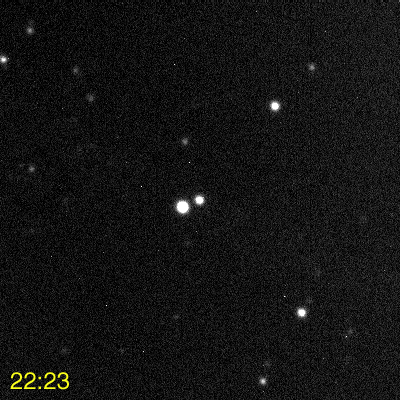
On January 11, 2003 the asteroid Davida was observed between 10:23 and 11:59 PM EST with the Bowling Green (OH) State University 0.5m telescope and CCD. The six images (each a 10 second exposure) were combined into the movie shown below. The time of each exposure is included on the frame. The field of view is approximately 7 by 7 arcminutes, with North at the bottom and East on the left. Davida was traveling at 0.55 arcseconds/minute towards the West-Northwest, meaning it moved about 53 arcseconds over the course of the observations. The visual magnitude was 9.9, about 100 times fainter than the faintest object one can see with the unaided eye (about 5th or 6th magnitude). Although it may seem that Davida is faint, it could be easily observed with a small telescope.
Davida was discovered on May 30, 1903 by R. S. Dugan in Heidelberg, Germany. The (511) in Davida's title means it was the 511th asteroid to be included in the list of asteroids maintained by the International Astronomical Union. Davida orbits at an average distance from the Sun of 3.17 AU, placing it a little under halfway between Mars and Jupiter. Davida takes about 5.64 years to orbit the Sun. The eccentricity (flatness of the ellipse) of its orbit is about 0.18, making its orbit less eccentric than that of Mercury's or Pluto's, but more eccentric than any of the other planets'. Its orbit is inclined by about 15.9 degrees to the plane of the ecliptic (the plane in which the Earth orbits the Sun). This inclination is twice that of Mercury, which is the planet with the highest inclination other than that of Pluto's, which is about 17.2 degrees.
